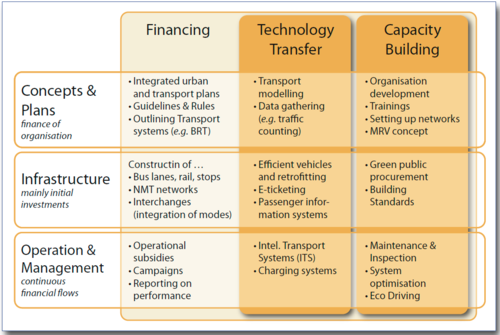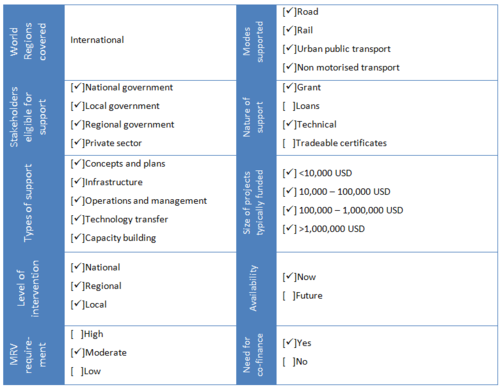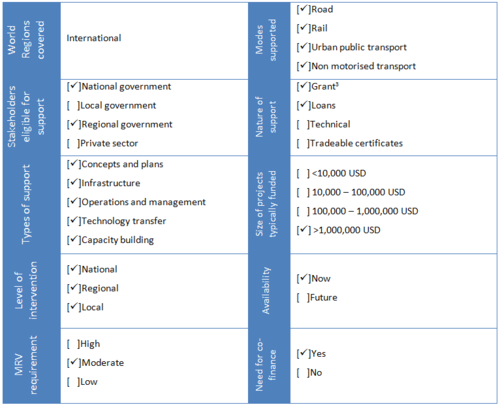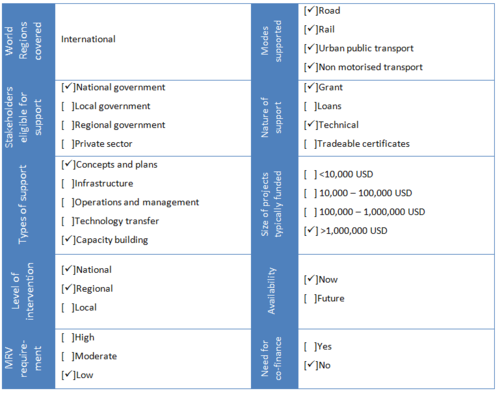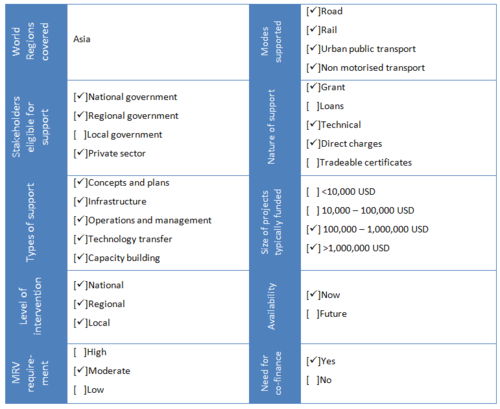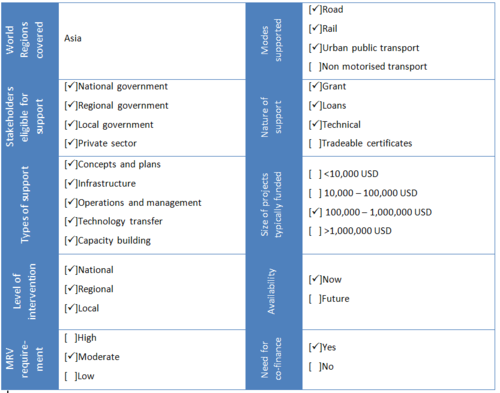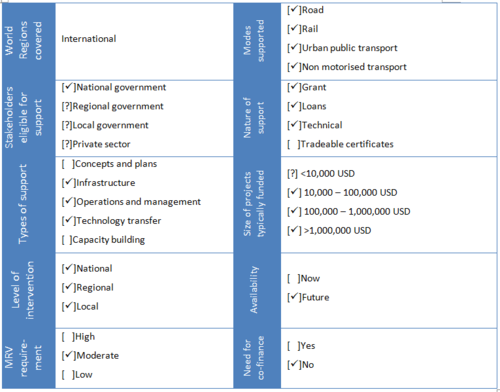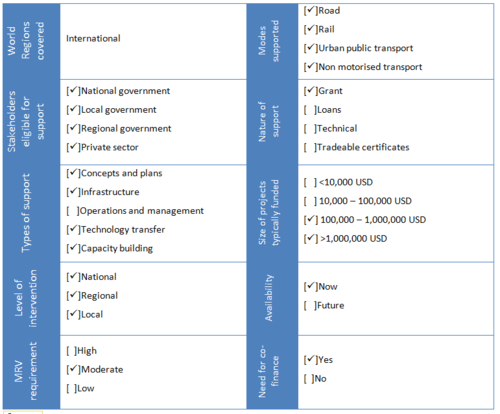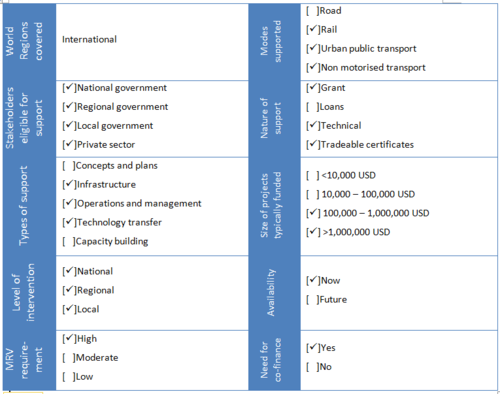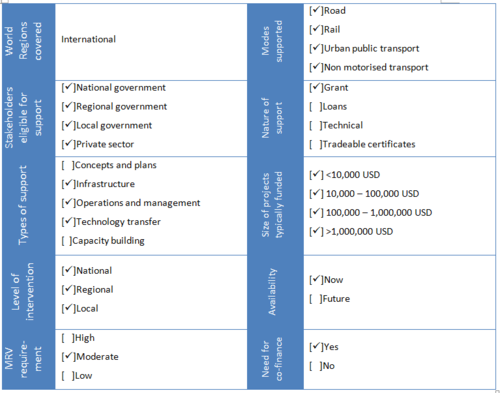Knowledge fuels change
For over a decade, Energypedia has shared free, reliable energy expertise with the world.
We’re now facing a serious funding gap.
Help keep this platform alive — your donation, big or small, truly matters!
Thank you for your support
Difference between revisions of "Assessing Climate Finance for Sustainable Transport"
***** (***** | *****) m |
***** (***** | *****) m Tag: 2017 source edit |
||
| (4 intermediate revisions by 3 users not shown) | |||
| Line 1: | Line 1: | ||
| − | + | [[Portal:Mobility|►Back to Mobility Portal]] | |
| − | Climate change is an international threat that requires an international response from all sectors of the economy in all countries of the world. In the transport sector energy related | + | = Overview = |
| + | |||
| + | [[Climate Change and Transport|Climate change]] is an international threat that requires an international response from all sectors of the economy in all countries of the world. In the transport sector energy related [[Emission Data Monitoring Technology|CO2 emissions]] are expected to increase by nearly 50% by 2030 and by more than 80% by 2050. Most of this growth is expected to occur in developing countries<ref name="International Energy Agency (IEA) (2009) World energy outlook 2009. Paris: IEA.">International Energy Agency (IEA) (2009) World energy outlook 2009. Paris: IEA.</ref> although little has been achieved in terms of '''greenhouse gas (GHG)''' reduction in the transport sector. This is linked to a lack of financial resources for implementing measures towards sustainable mobility, and specifically for climate change mitigation activities in the sector. | ||
In developing countries, there is a rapidly expanding recognition amongst policy makers of the need for sustainable climate change mitigation transport policies, programmes and projects that deliver low carbon growth whilst delivering environmental, social and economic benefits (‘co benefits’). Co-benefits that can be derived from low carbon climate change mitigation transport initiatives include reduced congestion, enhanced accessibility, improved air quality and local employment opportunities. | In developing countries, there is a rapidly expanding recognition amongst policy makers of the need for sustainable climate change mitigation transport policies, programmes and projects that deliver low carbon growth whilst delivering environmental, social and economic benefits (‘co benefits’). Co-benefits that can be derived from low carbon climate change mitigation transport initiatives include reduced congestion, enhanced accessibility, improved air quality and local employment opportunities. | ||
| Line 8: | Line 10: | ||
These interventions require resources and the availability of climate finance is often an incentive for their development. This paper intends to reduce the financial barriers to the development and implementation of sustainable climate change mitigation transport strategies by outlining the climate finance available for activities in the transport sector. | These interventions require resources and the availability of climate finance is often an incentive for their development. This paper intends to reduce the financial barriers to the development and implementation of sustainable climate change mitigation transport strategies by outlining the climate finance available for activities in the transport sector. | ||
| − | The nature, availability and eligibility for climate finance is currently dynamic with sources and conditions frequently evolving. This is particularly true owing to numerous unresolved issues relating to the UNFCCC negotiation process, which have direct implications for the international climate finance architecture<ref name="Anne Binsted, Daniel Bongardt, Dalkmann Holger, Sakamoto Ko, Millard Katie, Bond Duncan, Allen Heather 2013, Assessing Climate Finance for Sustainable Transport: A practical overview, updated version of 2013, Eschborn, Germany">Anne Binsted, Daniel Bongardt, Dalkmann Holger, Sakamoto Ko, Millard Katie, Bond Duncan, Allen Heather 2013, Assessing Climate Finance for Sustainable Transport: A practical overview, updated version of 2013, Eschborn, Germany</ref>. | + | The nature, availability and eligibility for climate finance is currently dynamic with sources and conditions frequently evolving. This is particularly true owing to numerous unresolved issues relating to the UNFCCC negotiation process, which have direct implications for the international climate finance architecture<ref name="Anne Binsted, Daniel Bongardt, Dalkmann Holger, Sakamoto Ko, Millard Katie, Bond Duncan, Allen Heather 2013, Assessing Climate Finance for Sustainable Transport: A practical overview, updated version of 2013, Eschborn, Germany">Anne Binsted, Daniel Bongardt, Dalkmann Holger, Sakamoto Ko, Millard Katie, Bond Duncan, Allen Heather 2013, Assessing Climate Finance for Sustainable Transport: A practical overview, updated version of 2013, Eschborn, Germany</ref>. |
| − | |||
| − | = What is climate finance? | + | |
| + | = What is climate finance? = | ||
The term ‘climate finance’ is used to describe funding that can be used to support climate change mitigation and adaptation activities. | The term ‘climate finance’ is used to describe funding that can be used to support climate change mitigation and adaptation activities. | ||
| − | Climate finance can, however, provide considerable resources | + | Climate finance can, however, provide considerable resources ring fenced specifically for climate change mitigation activities. It can encompass both public and private sources of finance and can be used to support activities in all sectors of the economy in both developed and developing countries. In doing so it can play a key role in the ‘shift and scaling up of funding’ for sustainable low carbon transports which directly contributes to the enactment of sustainable transport on a larger scale. It can have a particular impact where sustainable transport interventions require funding from a combination of sources and when the availability of climate finance can push an activity beyond the tipping point that determines whether or not an intervention can be implemented. |
| − | + | [[Assessing_Climate_Finance_for_Sustainable_Transport#toc|►Go to Top]] | |
| − | = What climate change mitigation transport interventions can climate finance fund? | + | = What climate change mitigation transport interventions can climate finance fund? = |
| − | The type of activities that climate finance can be used to fund in the land transport sector can be | + | The type of activities that climate finance can be used to fund in the land transport sector can be summarized along three categories, concepts and plans, infrastructure as well as operation and maintenance as shown in the figure below. |
| − | |||
| − | |||
| − | + | [[File:Types of climate change mitigation activities that can be supported by climate finance..png|thumb|center|500px|Types of climate change mitigation activities that can be supported by climate finance|alt=Types of climate change mitigation activities that can be supported by climate finance..png]] | |
| − | |||
| − | |||
| − | ''' | + | '''Concepts and plans'''. One of the first stages of climate change mitigation activities is developing concepts and plans. They can relate to anything from an individual intervention to a city or nationwide strategy and low carbon transport systems depend upon the effective and informed development of the concepts and plans upon which they are based. |
| − | ''' | + | '''Infrastructure'''. Transport infrastructure can be broadly defined as the physical transport network that pedestrians and vehicles travel on, i.e. roads, railways and other forms of track such as bus ways. The term infrastructure encompasses the nodes or terminals of these ‘networks,’ such as railway and bus stations, but also the energy efficient vehicles. Climate finance investment is largely allocated to infrastructure for relatively sustainable modes of transport. |
| − | Capacity building. Climate finance invested in capacity building is likely to focus on supporting one of the following (each of which could relate to infrastructure, operations and/or technology): | + | '''Operation and management''' refers to the elements that control the infrastructure as well as the vehicles and people that use the infrastructure. Operational interventions focus on road traffic management (engineering and software based) and public transport management (such as integration, scheduling, routing and setting fares). It can also include system wide approaches, such as electronic road tolls. |
| + | |||
| + | '''Technology transfer.''' Developing countries can benefit from technology based on that used in developed countries or developing countries. The latter can be particularly beneficial as solutions that work in developing countries are often different to those which work in developed countries. Technology can take many forms, including concepts and operations. | ||
| + | |||
| + | <u>Capacity building. Climate finance invested in capacity building is likely to focus on supporting one of the following (each of which could relate to infrastructure, operations and/or technology):</u> | ||
#The establishment or development of institutions, | #The establishment or development of institutions, | ||
#Training in sustainable transport and related issues, or | #Training in sustainable transport and related issues, or | ||
#Processes to enable activities to be measurable, reportable and verifiable (MRV). | #Processes to enable activities to be measurable, reportable and verifiable (MRV). | ||
| − | Climate finance can also help developing countries to meet the eligibility requirements of other sources of climate finance that require interventions to be conducted in a framework that enables any emission reductions that may result to be measurable, reportable and verifiable. | + | Climate finance can also help developing countries to meet the eligibility requirements of other sources of climate finance that require interventions to be conducted in a framework that enables any emission reductions that may result to be measurable, reportable and verifiable. |
| − | + | [[Assessing_Climate_Finance_for_Sustainable_Transport#toc|►Go to Top]] | |
| − | = Sources of Climate Finance | + | = Sources of Climate Finance = |
| − | + | == Climate Funds == | |
| − | + | Climate funds are sources of finance that are earmarked specifically for investment in climate change mitigation or adaptation activities (although please note that this guidance does not cover adaptation). They vary considerably in their scale, scope and in the specific type of climate change activities that they fund, but all activities that they support must address climate change concerns. | |
| − | + | [[Assessing_Climate_Finance_for_Sustainable_Transport#toc|►Go to Top]] | |
| − | |||
| − | |||
| − | + | === Global Environment Facility (GEF) === | |
| − | GEF | + | The GEF is an operating entity of the financial mechanism of the UNFCCC, which means that it supports almost all of the developing countries in the world to promote climate change mitigation (and adaptation) actions under the framework of the UNFCCC. In terms of climate change mitigation and enabling activities, from its inception in 1991 until June 30, 2010, the GEF supported 738 projects by providing grants with a total value of $2.9 billion to 154 developing countries and economies in transition. |
| − | < | + | GEF has supported sustainable urban transport projects since 1999 and sustainable urban transport is an emerging focus of the GEF interventions. The GEF’s aim is to facilitate market transformation (i.e. to support a positive shift away from a business as usual or do nothing scenario) for sustainable mobility in urban areas<ref name="For details of these types of support see http://www.thegef.org/gef/project_types.">For details of these types of support see http://www.thegef.org/gef/project_types.</ref>. |
| − | |||
| − | |||
| − | === Clean Technology Fund (CTF) | + | [[File:Global Environment Facility (GEF).png|thumb|center|500px|Global Environment Facility (GEF)|alt=Global Environment Facility (GEF).png]] |
| + | |||
| + | |||
| + | |||
| + | [[Assessing_Climate_Finance_for_Sustainable_Transport#toc|►Go to Top]] | ||
| + | |||
| + | === Clean Technology Fund (CTF) === | ||
<div> | <div> | ||
The CIF is an interim source of finance created in 2008 by the World Bank in co-operation with Multilateral Development Banks (MDBs) to bridge the gap between the current and future climate regime under the UNFCCC. Its specific aim was to promote scaled-up financing for the demonstration, deployment and transfer of low-carbon technologies whilst also providing insights into issues such as governance, leveraging and scalability. | The CIF is an interim source of finance created in 2008 by the World Bank in co-operation with Multilateral Development Banks (MDBs) to bridge the gap between the current and future climate regime under the UNFCCC. Its specific aim was to promote scaled-up financing for the demonstration, deployment and transfer of low-carbon technologies whilst also providing insights into issues such as governance, leveraging and scalability. | ||
| − | The CTF, as with the SCF, is designed to complement and leverage additional private sector, bilateral and multilateral sources of finance (i.e. development finance) and to assist developing countries to fill funding gaps for initiatives to mitigation against climate change and to strengthen resilience to climate change impacts. | + | The CTF, as with the SCF, is designed to complement and leverage additional private sector, bilateral and multilateral sources of finance (i.e. development finance) and to assist developing countries to fill funding gaps for initiatives to mitigation against climate change and to strengthen resilience to climate change impacts. |
| + | |||
| + | |||
| − | + | [[File:Clean Technology Fund (CTF).png|thumb|center|500px|Clean Technology Fund (CTF)|alt=Clean Technology Fund (CTF).png]] | |
| − | |||
| − | |||
| − | === Global Climate Change Alliance (GCCA) | + | [[Assessing_Climate_Finance_for_Sustainable_Transport#toc|►Go to Top]] |
| + | |||
| + | === Global Climate Change Alliance (GCCA) === | ||
The GCCA was developed by the EC in 2007 in recognition of the need for a ‘Global Climate Change Alliance’ between the EU and the most vulnerable developing countries. It is managed by the EC and its role is to ‘lead EU support and co-operation’ with the most vulnerable developing countries to address poverty and climate change and in doing so to support the achievement of the MDGs. The GCCA does this by providing both financial and technical support to beneficiary countries. | The GCCA was developed by the EC in 2007 in recognition of the need for a ‘Global Climate Change Alliance’ between the EU and the most vulnerable developing countries. It is managed by the EC and its role is to ‘lead EU support and co-operation’ with the most vulnerable developing countries to address poverty and climate change and in doing so to support the achievement of the MDGs. The GCCA does this by providing both financial and technical support to beneficiary countries. | ||
| − | + | ||
<u>The two objectives of the GCCA are to:</u> | <u>The two objectives of the GCCA are to:</u> | ||
| Line 91: | Line 97: | ||
*Increase support to specific countries to implement priority adaptation and mitigation measures and to integrate climate change issues into their development strategies. | *Increase support to specific countries to implement priority adaptation and mitigation measures and to integrate climate change issues into their development strategies. | ||
| − | |||
| − | |||
| − | < | + | The initiatives that have been funded to date range in value from €2 million to €13.7 million and have constituted between 9% to 100% of total project costs<ref name="For a list of all projects supported to date see http://www.gcca.eu/usr//GCCA_beneficiaries.pdf.">For a list of all projects supported to date see http://www.gcca.eu/usr//GCCA_beneficiaries.pdf.</ref>. In 2008 the European Parliament called for the GCCA to have a budget of ‘at least €2 billion annually by 2010 and €5 to 10 billion annually by 2020’<ref name="See Implementation framework.EC Staff working documents SEC (2008) 2319.pdf http://www.gcca.eu/usr/GCCA Implementation framework.EC Staff working documents SEC (2008) 2319.pdf">See Implementation framework.EC Staff working documents SEC (2008) 2319.pdf http://www.gcca.eu/usr/GCCA Implementation framework.EC Staff working documents SEC (2008) 2319.pdf</ref>.The GCCA is financed by the EC and its member states. |
| + | |||
| + | |||
| + | |||
| + | [[File:Global Climate Change Alliance (GCCA).png|thumb|center|500px|Global Climate Change Alliance (GCCA)|alt=Global Climate Change Alliance (GCCA).png]] | ||
| + | |||
| + | |||
| + | |||
| + | [[Assessing_Climate_Finance_for_Sustainable_Transport#toc|►Go to Top]] | ||
| + | |||
| + | === IDB’s Sustainable Energy and Climate Change Initiative (SECCI) === | ||
| − | + | The IDB’s '''Sustainable Energy and Climate Change Initiative (SECCI)''' was established in 2007. The focus of SECCI is on its four pillars: to increase investment in energy efficiency technologies, to increase investment in renewable energy (particularly biofuels), to increase access to international carbon finance, and to mainstream adaptation across sectors of Latin America and the Caribbean. | |
| − | |||
| − | |||
| − | + | A considerable proportion of the SECCI funds are used to provide support for policy reforms to complement project level assistance. Activities that they support include developing and implementing national assessments, analysing policies, supporting policy reforms required to facilitate the four main pillars of SECCI (as listed above), and supporting project identification, preparation and capacity building<ref name="See http://idbdocs.iadb.org/wsdocs/getdocument.aspx?docnum=35347205.">See http://idbdocs.iadb.org/wsdocs/getdocument.aspx?docnum=35347205.</ref>. | |
| − | |||
| − | |||
| − | + | [[File:IDB’s Sustainable Energy and Climate Change Initiative (SECCI).png|thumb|center|500px|IDB’s Sustainable Energy and Climate Change Initiative (SECCI)|alt=IDB’s Sustainable Energy and Climate Change Initiative (SECCI).png]] | |
| − | |||
| − | + | ||
| + | [[Assessing_Climate_Finance_for_Sustainable_Transport#toc|►Go to Top]] | ||
=== ADB Climate Change Fund === | === ADB Climate Change Fund === | ||
<div> | <div> | ||
| − | The CCF was established in 2008 to provide grants, technical assistance and co-financing to the ADB’s developing member countries. It was established under the ADB’s Clean Energy and Environment Program (CE&EP) - the programme under which the ADB conducts its climate change mitigation efforts. It was specifically launched under the ‘Energy for All Initiative’ – one of seven initiatives of the CE&EP. The aim of the CCF is to facilitate greater investments by providing grants for knowledge, technical assistance and finance. The ADB envisages that 70% of the support will be comprised of grants and 30% of technical assistance, all of which will be funded from the ADB’s net income. | + | The CCF was established in 2008 to provide grants, technical assistance and co-financing to the ADB’s developing member countries. It was established under the ADB’s '''Clean Energy and Environment Program (CE&EP)''' - the programme under which the ADB conducts its climate change mitigation efforts. It was specifically launched under the ‘Energy for All Initiative’ – one of seven initiatives of the CE&EP. The aim of the CCF is to facilitate greater investments by providing grants for knowledge, technical assistance and finance. The ADB envisages that 70% of the support will be comprised of grants and 30% of technical assistance, all of which will be funded from the ADB’s net income. |
| − | |||
| − | |||
| − | < | + | The CCF has two components: the '''Clean Energy Working Group (CEWG)''' and the '''Adaptation and Land Use Working Group (ALUWG)'''. The former component supports climate change mitigation in the transport sector. US$25 million of the CCF’s initial US$40 million budget was allocated to mitigation activities in sectors including transport. It is envisaged that approximately 75% of the CCF’s available funding will be allocated to mitigation activities<ref name="See http://www.adb.org/Clean-Energy/documents/CCF-implementation-guidelines.pdf.">See http://www.adb.org/Clean-Energy/documents/CCF-implementation-guidelines.pdf.</ref>. |
| − | |||
| − | |||
| − | === ADB Clean Energy Fund (CEF) | + | [[File:ADB Climate Change Fund.png|thumb|center|500px|ADB Climate Change Fund|alt=ADB Climate Change Fund.png]] |
| + | |||
| + | [[Assessing_Climate_Finance_for_Sustainable_Transport#toc|►Go to Top]] | ||
| + | |||
| + | === ADB Clean Energy Fund (CEF) === | ||
This Facility was established in 2007 to support policy, regulatory and institutional reforms that can improve the energy efficiency and security of developing member countries with the ultimate goal of reducing climate change impacts. It was created under the ADB’s Clean Energy and Environment Program (CE&EP), as was the previously detailed CCF. | This Facility was established in 2007 to support policy, regulatory and institutional reforms that can improve the energy efficiency and security of developing member countries with the ultimate goal of reducing climate change impacts. It was created under the ADB’s Clean Energy and Environment Program (CE&EP), as was the previously detailed CCF. | ||
| − | |||
| − | |||
| − | + | Actions are supported that foster strategic, long-term, multi-partner co-operation and take the form of trust grants, project specific financing (grants, concessional loans or guarantees), knowledge provision and exchange, or ‘''any other form of co-operation’'' for a defined programme of activities. The ADB envisages that approximately 70% of finance allocated under the CEF will be for grants and 30% for technical assistance and that, across all sectors, they will give preference to the demonstration and deployment of new technologies and associated capacity building. | |
| − | |||
| − | |||
| − | === Hayotama Initiative | + | [[File:ADB Clean Energy Fund (CEF).png|thumb|center|500px|ADB Clean Energy Fund (CEF)|alt=ADB Clean Energy Fund (CEF).png]] |
| + | |||
| + | [[Assessing_Climate_Finance_for_Sustainable_Transport#toc|►Go to Top]] | ||
| + | |||
| + | === Hayotama Initiative === | ||
The launch of the Hayotama Initiative was announced in September 2009. It is a national Japanese initiative that aims to support developing countries that are already taking steps to reduce GHG emissions in a way that supports economic growth and/or those that are particularly vulnerable to climate change. | The launch of the Hayotama Initiative was announced in September 2009. It is a national Japanese initiative that aims to support developing countries that are already taking steps to reduce GHG emissions in a way that supports economic growth and/or those that are particularly vulnerable to climate change. | ||
| − | The Initiative is administered by the Japanese Ministry of Foreign Affairs as well as by other public and private organisations including the Japan International Cooperation Agency (JICA). As part of the Initiative, Japan has pledged its fast start financing (see Section 5) to invest US$15 billion until 2012 (US$11 billion from public sources and the rest from private). | + | The Initiative is administered by the Japanese Ministry of Foreign Affairs as well as by other public and private organisations including the '''Japan International Cooperation Agency (JICA)'''. As part of the Initiative, Japan has pledged its fast start financing (see Section 5) to invest US$15 billion until 2012 (US$11 billion from public sources and the rest from private). |
| − | [[File:Hayotama Initiative.png| | + | [[File:Hayotama Initiative.png|thumb|center|500px|Hayotama Initiative|alt=Hayotama Initiative.png]] |
| − | + | [[Assessing_Climate_Finance_for_Sustainable_Transport#toc|►Go to Top]] | |
| − | === German International Climate Initiative (ICI) | + | === German International Climate Initiative (ICI) === |
<div> | <div> | ||
| − | The ICI was established in 2008 to complement Germany’s existing development assistance. It supports climate change mitigation and adaptation in transition (in Central and Eastern Europe), developing and newly industrialising countries. The ICI has a budget of approximately €120 million a year. It focuses on financing activities on both a regional and a thematic level. Its thematic focus is on projects and activities that: promote a climate-friendly economy; promote measures for adaptation to the impacts of climate change; and promote measures for the preservation and sustainable use of natural carbon sinks. At present approximately 60% of the ICI projects involve measures to reduce emissions, with a particular emphasis on energy efficiency and renewable energy<ref name="See http://www.bmu-klimaschutzinitiative.de/en/results.">See http://www.bmu-klimaschutzinitiative.de/en/results.</ref>. | + | The ICI was established in 2008 to complement Germany’s existing development assistance. It supports climate change mitigation and adaptation in transition (in Central and Eastern Europe), developing and newly industrialising countries. The ICI has a budget of approximately €120 million a year. It focuses on financing activities on both a regional and a thematic level. Its thematic focus is on projects and activities that: promote a climate-friendly economy; promote measures for adaptation to the impacts of climate change; and promote measures for the preservation and sustainable use of natural carbon sinks. At present approximately 60% of the ICI projects involve measures to reduce emissions, with a particular emphasis on energy efficiency and renewable energy<ref name="See http://www.bmu-klimaschutzinitiative.de/en/results.">See http://www.bmu-klimaschutzinitiative.de/en/results.</ref>. |
| + | |||
| + | |||
| − | + | [[File:German International Climate Initiative (ICI).png|thumb|center|500px|German International Climate Initiative (ICI)|alt=German International Climate Initiative (ICI).png]] | |
| − | [[ | + | [[Assessing_Climate_Finance_for_Sustainable_Transport#toc|►Go to Top]] |
| − | + | == Carbon Market == | |
| − | == | + | === Clean Development Mechanism (CDM) === |
| − | + | The CDM operates through the sale of '''Certified Emission Reductions (CERs)''' on the compliance carbon market. It was introduced under the Kyoto Protocol to enable activities that can reduce GHGs in a way that can be measured and certified using methodologies approved by the UNFCCC to obtain finance for these activities through the sale of officially certified emission reductions (CERs). These emissions are sold on the carbon market, which is why the CDM is often referred to as a ‘market based mechanism,’ to private companies and industrialised countries. In this way it enables industrialised countries with an international obligation to meet certain GHG reduction targets to invest in projects that are capable of reducing GHG emissions in developing countries as an alternative to taking action in their own countries. | |
| − | |||
| − | |||
| − | < | + | The CDM started operating in 2006 and has since become one of the main instruments used for the funding of climate change mitigation projects in developing countries. From its inception in 2006 until the end of September 2010 it had registered 2,403 projects, which are collectively expected to lead to the reduction of approximately 1,830 million tonnes of CO<sub>2</sub> equivalent by the end of 2012. The registered projects have collectively obtained US$72,903 million in investment<ref name="See http://cdm.unfccc.int/Statistics/index.html.">See http://cdm.unfccc.int/Statistics/index.html.</ref>. In addition, at the beginning of September 2010, there were 5,443 CDM projects in the CDM pipeline<ref name="See http://cdmpipeline.org/.">See http://cdmpipeline.org/.</ref>. |
| − | |||
| − | |||
| − | [[File:Clean Development Mechanism (CDM).png| | + | [[File:Clean Development Mechanism (CDM).png|thumb|center|500px|Clean Development Mechanism (CDM)|alt=Clean Development Mechanism (CDM).png]] |
| − | + | [[Assessing_Climate_Finance_for_Sustainable_Transport#toc|►Go to Top]] | |
<div> | <div> | ||
=== Voluntary Carbon Markets === | === Voluntary Carbon Markets === | ||
| Line 185: | Line 193: | ||
The voluntary carbon market enables organisations, individuals and governments to purchase carbon offsets that have been realised by climate change mitigation activities on a voluntary basis. The purchase of emission reduction credits on the voluntary market is not motivated by international legally binding emission reduction commitments, although some businesses have developed their own self-imposed emission reduction commitments using the voluntary market. The motivation for actors to buy emission credits on the voluntary market tends to be driven by marketing or public relation purposes with many organisations and events, for example, choosing to offset their emissions by purchasing credits on the voluntary markets. | The voluntary carbon market enables organisations, individuals and governments to purchase carbon offsets that have been realised by climate change mitigation activities on a voluntary basis. The purchase of emission reduction credits on the voluntary market is not motivated by international legally binding emission reduction commitments, although some businesses have developed their own self-imposed emission reduction commitments using the voluntary market. The motivation for actors to buy emission credits on the voluntary market tends to be driven by marketing or public relation purposes with many organisations and events, for example, choosing to offset their emissions by purchasing credits on the voluntary markets. | ||
| − | The voluntary carbon market is still relatively new and considerably smaller than the compliance market. The demand for credits and the price of carbon fluctuate and will continue to do so but it is widely predicted that the scale of the voluntary market will grow. In 2009 the voluntary market is estimated to have offset 46 megatonnes of CO<sub>2</sub> equivalent with a value of US$3,370 million<ref name="World Bank (2010) State and trends of the carbon market. Accessible from http://siteresources.worldbank.org/INTCARBONFINANCE/Resources/State_and_Trends_of_the_Carbon_Market_2010_low_res.pdf.">World Bank (2010) State and trends of the carbon market. Accessible from http://siteresources.worldbank.org/INTCARBONFINANCE/Resources/State_and_Trends_of_the_Carbon_Market_2010_low_res.pdf.</ref>. | + | The voluntary carbon market is still relatively new and considerably smaller than the compliance market. The demand for credits and the price of carbon fluctuate and will continue to do so but it is widely predicted that the scale of the voluntary market will grow. In 2009 the voluntary market is estimated to have offset 46 megatonnes of CO<sub>2</sub> equivalent with a value of US$3,370 million<ref name="World Bank (2010) State and trends of the carbon market. Accessible from http://siteresources.worldbank.org/INTCARBONFINANCE/Resources/State_and_Trends_of_the_Carbon_Market_2010_low_res.pdf.">World Bank (2010) State and trends of the carbon market. Accessible from http://siteresources.worldbank.org/INTCARBONFINANCE/Resources/State_and_Trends_of_the_Carbon_Market_2010_low_res.pdf.</ref>. |
| + | |||
| − | |||
| − | [[File:Voluntary Carbon Market.png| | + | [[File:Voluntary Carbon Market.png|thumb|center|500px|alt=Voluntary Carbon Market.png]] |
| − | + | [[Assessing_Climate_Finance_for_Sustainable_Transport#toc|►Go to Top]] | |
| − | = Outlook | + | = Outlook = |
<div> | <div> | ||
Transport is increasingly being recognised as a sector that has been underrepresented in climate finance. Whatever the future of carbon finance it therefore seems likely that transport will play an enhanced role within it and that the volume of finance available from these sources will increase. Climate finance is a dynamic and rapidly evolving area and COP 15 in Copenhagen industrialized countries committed to provide 100 billion USD annually until 2020. | Transport is increasingly being recognised as a sector that has been underrepresented in climate finance. Whatever the future of carbon finance it therefore seems likely that transport will play an enhanced role within it and that the volume of finance available from these sources will increase. Climate finance is a dynamic and rapidly evolving area and COP 15 in Copenhagen industrialized countries committed to provide 100 billion USD annually until 2020. | ||
| Line 199: | Line 207: | ||
However, with the commitment period of the Kyoto Protocol (the international climate change agreement forged by the UNFCCC) coming to an end in 2012 and no new climate regime agreed, it is not known what form the international climate finance architecture will take. | However, with the commitment period of the Kyoto Protocol (the international climate change agreement forged by the UNFCCC) coming to an end in 2012 and no new climate regime agreed, it is not known what form the international climate finance architecture will take. | ||
| − | |||
| − | |||
| − | Further and more detailed information can be found on the homepage of the [http://www.sutp.org/ Sustainable Urban Transport Project]. The Sustainable Urban Transport Project aims to help developing world cities achieve their sustainable transport goals, through the dissemination of information about international experience, policy advice, training and capacity building. | + | = Further Information = |
| + | |||
| + | *Further and more detailed information can be found on the homepage of the [http://www.sutp.org/ Sustainable Urban Transport Project]. The Sustainable Urban Transport Project aims to help developing world cities achieve their sustainable transport goals, through the dissemination of information about international experience, policy advice, training and capacity building. | ||
| + | *[[Emission Data Monitoring Technology|Emission Data Monitoring Technology]] | ||
| + | *[[Climate Change and Transport|Climate Change and Transport]] | ||
| − | |||
| − | |||
| − | <references | + | = References = |
| + | |||
| + | <references /> | ||
</div></div></div></div></div> | </div></div></div></div></div> | ||
| − | |||
| + | |||
| + | [[Category:Climate_Change]] | ||
| + | [[Category:Climate_Change_Mitigation]] | ||
| + | [[Category:Transport]] | ||
[[Category:Mobility]] | [[Category:Mobility]] | ||
| − | |||
| − | |||
| − | |||
Latest revision as of 18:30, 15 September 2021
Overview
Climate change is an international threat that requires an international response from all sectors of the economy in all countries of the world. In the transport sector energy related CO2 emissions are expected to increase by nearly 50% by 2030 and by more than 80% by 2050. Most of this growth is expected to occur in developing countries[1] although little has been achieved in terms of greenhouse gas (GHG) reduction in the transport sector. This is linked to a lack of financial resources for implementing measures towards sustainable mobility, and specifically for climate change mitigation activities in the sector.
In developing countries, there is a rapidly expanding recognition amongst policy makers of the need for sustainable climate change mitigation transport policies, programmes and projects that deliver low carbon growth whilst delivering environmental, social and economic benefits (‘co benefits’). Co-benefits that can be derived from low carbon climate change mitigation transport initiatives include reduced congestion, enhanced accessibility, improved air quality and local employment opportunities.
These interventions require resources and the availability of climate finance is often an incentive for their development. This paper intends to reduce the financial barriers to the development and implementation of sustainable climate change mitigation transport strategies by outlining the climate finance available for activities in the transport sector.
The nature, availability and eligibility for climate finance is currently dynamic with sources and conditions frequently evolving. This is particularly true owing to numerous unresolved issues relating to the UNFCCC negotiation process, which have direct implications for the international climate finance architecture[2].
What is climate finance?
The term ‘climate finance’ is used to describe funding that can be used to support climate change mitigation and adaptation activities.
Climate finance can, however, provide considerable resources ring fenced specifically for climate change mitigation activities. It can encompass both public and private sources of finance and can be used to support activities in all sectors of the economy in both developed and developing countries. In doing so it can play a key role in the ‘shift and scaling up of funding’ for sustainable low carbon transports which directly contributes to the enactment of sustainable transport on a larger scale. It can have a particular impact where sustainable transport interventions require funding from a combination of sources and when the availability of climate finance can push an activity beyond the tipping point that determines whether or not an intervention can be implemented.
What climate change mitigation transport interventions can climate finance fund?
The type of activities that climate finance can be used to fund in the land transport sector can be summarized along three categories, concepts and plans, infrastructure as well as operation and maintenance as shown in the figure below.
Concepts and plans. One of the first stages of climate change mitigation activities is developing concepts and plans. They can relate to anything from an individual intervention to a city or nationwide strategy and low carbon transport systems depend upon the effective and informed development of the concepts and plans upon which they are based.
Infrastructure. Transport infrastructure can be broadly defined as the physical transport network that pedestrians and vehicles travel on, i.e. roads, railways and other forms of track such as bus ways. The term infrastructure encompasses the nodes or terminals of these ‘networks,’ such as railway and bus stations, but also the energy efficient vehicles. Climate finance investment is largely allocated to infrastructure for relatively sustainable modes of transport.
Operation and management refers to the elements that control the infrastructure as well as the vehicles and people that use the infrastructure. Operational interventions focus on road traffic management (engineering and software based) and public transport management (such as integration, scheduling, routing and setting fares). It can also include system wide approaches, such as electronic road tolls.
Technology transfer. Developing countries can benefit from technology based on that used in developed countries or developing countries. The latter can be particularly beneficial as solutions that work in developing countries are often different to those which work in developed countries. Technology can take many forms, including concepts and operations.
Capacity building. Climate finance invested in capacity building is likely to focus on supporting one of the following (each of which could relate to infrastructure, operations and/or technology):
- The establishment or development of institutions,
- Training in sustainable transport and related issues, or
- Processes to enable activities to be measurable, reportable and verifiable (MRV).
Climate finance can also help developing countries to meet the eligibility requirements of other sources of climate finance that require interventions to be conducted in a framework that enables any emission reductions that may result to be measurable, reportable and verifiable.
Sources of Climate Finance
Climate Funds
Climate funds are sources of finance that are earmarked specifically for investment in climate change mitigation or adaptation activities (although please note that this guidance does not cover adaptation). They vary considerably in their scale, scope and in the specific type of climate change activities that they fund, but all activities that they support must address climate change concerns.
Global Environment Facility (GEF)
The GEF is an operating entity of the financial mechanism of the UNFCCC, which means that it supports almost all of the developing countries in the world to promote climate change mitigation (and adaptation) actions under the framework of the UNFCCC. In terms of climate change mitigation and enabling activities, from its inception in 1991 until June 30, 2010, the GEF supported 738 projects by providing grants with a total value of $2.9 billion to 154 developing countries and economies in transition.
GEF has supported sustainable urban transport projects since 1999 and sustainable urban transport is an emerging focus of the GEF interventions. The GEF’s aim is to facilitate market transformation (i.e. to support a positive shift away from a business as usual or do nothing scenario) for sustainable mobility in urban areas[3].
Clean Technology Fund (CTF)
The CIF is an interim source of finance created in 2008 by the World Bank in co-operation with Multilateral Development Banks (MDBs) to bridge the gap between the current and future climate regime under the UNFCCC. Its specific aim was to promote scaled-up financing for the demonstration, deployment and transfer of low-carbon technologies whilst also providing insights into issues such as governance, leveraging and scalability.
The CTF, as with the SCF, is designed to complement and leverage additional private sector, bilateral and multilateral sources of finance (i.e. development finance) and to assist developing countries to fill funding gaps for initiatives to mitigation against climate change and to strengthen resilience to climate change impacts.
Global Climate Change Alliance (GCCA)
The GCCA was developed by the EC in 2007 in recognition of the need for a ‘Global Climate Change Alliance’ between the EU and the most vulnerable developing countries. It is managed by the EC and its role is to ‘lead EU support and co-operation’ with the most vulnerable developing countries to address poverty and climate change and in doing so to support the achievement of the MDGs. The GCCA does this by providing both financial and technical support to beneficiary countries.
The two objectives of the GCCA are to:
- Deepen the climate change policy dialogue between the EU and developing countries (with an emphasis on the UNFCCC negotiations)
- Increase support to specific countries to implement priority adaptation and mitigation measures and to integrate climate change issues into their development strategies.
The initiatives that have been funded to date range in value from €2 million to €13.7 million and have constituted between 9% to 100% of total project costs[4]. In 2008 the European Parliament called for the GCCA to have a budget of ‘at least €2 billion annually by 2010 and €5 to 10 billion annually by 2020’[5].The GCCA is financed by the EC and its member states.
IDB’s Sustainable Energy and Climate Change Initiative (SECCI)
The IDB’s Sustainable Energy and Climate Change Initiative (SECCI) was established in 2007. The focus of SECCI is on its four pillars: to increase investment in energy efficiency technologies, to increase investment in renewable energy (particularly biofuels), to increase access to international carbon finance, and to mainstream adaptation across sectors of Latin America and the Caribbean.
A considerable proportion of the SECCI funds are used to provide support for policy reforms to complement project level assistance. Activities that they support include developing and implementing national assessments, analysing policies, supporting policy reforms required to facilitate the four main pillars of SECCI (as listed above), and supporting project identification, preparation and capacity building[6].
ADB Climate Change Fund
The CCF was established in 2008 to provide grants, technical assistance and co-financing to the ADB’s developing member countries. It was established under the ADB’s Clean Energy and Environment Program (CE&EP) - the programme under which the ADB conducts its climate change mitigation efforts. It was specifically launched under the ‘Energy for All Initiative’ – one of seven initiatives of the CE&EP. The aim of the CCF is to facilitate greater investments by providing grants for knowledge, technical assistance and finance. The ADB envisages that 70% of the support will be comprised of grants and 30% of technical assistance, all of which will be funded from the ADB’s net income.
The CCF has two components: the Clean Energy Working Group (CEWG) and the Adaptation and Land Use Working Group (ALUWG). The former component supports climate change mitigation in the transport sector. US$25 million of the CCF’s initial US$40 million budget was allocated to mitigation activities in sectors including transport. It is envisaged that approximately 75% of the CCF’s available funding will be allocated to mitigation activities[7].
ADB Clean Energy Fund (CEF)
This Facility was established in 2007 to support policy, regulatory and institutional reforms that can improve the energy efficiency and security of developing member countries with the ultimate goal of reducing climate change impacts. It was created under the ADB’s Clean Energy and Environment Program (CE&EP), as was the previously detailed CCF.
Actions are supported that foster strategic, long-term, multi-partner co-operation and take the form of trust grants, project specific financing (grants, concessional loans or guarantees), knowledge provision and exchange, or ‘any other form of co-operation’ for a defined programme of activities. The ADB envisages that approximately 70% of finance allocated under the CEF will be for grants and 30% for technical assistance and that, across all sectors, they will give preference to the demonstration and deployment of new technologies and associated capacity building.
Hayotama Initiative
The launch of the Hayotama Initiative was announced in September 2009. It is a national Japanese initiative that aims to support developing countries that are already taking steps to reduce GHG emissions in a way that supports economic growth and/or those that are particularly vulnerable to climate change.
The Initiative is administered by the Japanese Ministry of Foreign Affairs as well as by other public and private organisations including the Japan International Cooperation Agency (JICA). As part of the Initiative, Japan has pledged its fast start financing (see Section 5) to invest US$15 billion until 2012 (US$11 billion from public sources and the rest from private).
German International Climate Initiative (ICI)
The ICI was established in 2008 to complement Germany’s existing development assistance. It supports climate change mitigation and adaptation in transition (in Central and Eastern Europe), developing and newly industrialising countries. The ICI has a budget of approximately €120 million a year. It focuses on financing activities on both a regional and a thematic level. Its thematic focus is on projects and activities that: promote a climate-friendly economy; promote measures for adaptation to the impacts of climate change; and promote measures for the preservation and sustainable use of natural carbon sinks. At present approximately 60% of the ICI projects involve measures to reduce emissions, with a particular emphasis on energy efficiency and renewable energy[8].
Carbon Market
Clean Development Mechanism (CDM)
The CDM operates through the sale of Certified Emission Reductions (CERs) on the compliance carbon market. It was introduced under the Kyoto Protocol to enable activities that can reduce GHGs in a way that can be measured and certified using methodologies approved by the UNFCCC to obtain finance for these activities through the sale of officially certified emission reductions (CERs). These emissions are sold on the carbon market, which is why the CDM is often referred to as a ‘market based mechanism,’ to private companies and industrialised countries. In this way it enables industrialised countries with an international obligation to meet certain GHG reduction targets to invest in projects that are capable of reducing GHG emissions in developing countries as an alternative to taking action in their own countries.
The CDM started operating in 2006 and has since become one of the main instruments used for the funding of climate change mitigation projects in developing countries. From its inception in 2006 until the end of September 2010 it had registered 2,403 projects, which are collectively expected to lead to the reduction of approximately 1,830 million tonnes of CO2 equivalent by the end of 2012. The registered projects have collectively obtained US$72,903 million in investment[9]. In addition, at the beginning of September 2010, there were 5,443 CDM projects in the CDM pipeline[10].
Voluntary Carbon Markets
The voluntary carbon market enables organisations, individuals and governments to purchase carbon offsets that have been realised by climate change mitigation activities on a voluntary basis. The purchase of emission reduction credits on the voluntary market is not motivated by international legally binding emission reduction commitments, although some businesses have developed their own self-imposed emission reduction commitments using the voluntary market. The motivation for actors to buy emission credits on the voluntary market tends to be driven by marketing or public relation purposes with many organisations and events, for example, choosing to offset their emissions by purchasing credits on the voluntary markets.
The voluntary carbon market is still relatively new and considerably smaller than the compliance market. The demand for credits and the price of carbon fluctuate and will continue to do so but it is widely predicted that the scale of the voluntary market will grow. In 2009 the voluntary market is estimated to have offset 46 megatonnes of CO2 equivalent with a value of US$3,370 million[11].
Outlook
Transport is increasingly being recognised as a sector that has been underrepresented in climate finance. Whatever the future of carbon finance it therefore seems likely that transport will play an enhanced role within it and that the volume of finance available from these sources will increase. Climate finance is a dynamic and rapidly evolving area and COP 15 in Copenhagen industrialized countries committed to provide 100 billion USD annually until 2020.
However, with the commitment period of the Kyoto Protocol (the international climate change agreement forged by the UNFCCC) coming to an end in 2012 and no new climate regime agreed, it is not known what form the international climate finance architecture will take.
Further Information
- Further and more detailed information can be found on the homepage of the Sustainable Urban Transport Project. The Sustainable Urban Transport Project aims to help developing world cities achieve their sustainable transport goals, through the dissemination of information about international experience, policy advice, training and capacity building.
- Emission Data Monitoring Technology
- Climate Change and Transport
References
- ↑ International Energy Agency (IEA) (2009) World energy outlook 2009. Paris: IEA.
- ↑ Anne Binsted, Daniel Bongardt, Dalkmann Holger, Sakamoto Ko, Millard Katie, Bond Duncan, Allen Heather 2013, Assessing Climate Finance for Sustainable Transport: A practical overview, updated version of 2013, Eschborn, Germany
- ↑ For details of these types of support see http://www.thegef.org/gef/project_types.
- ↑ For a list of all projects supported to date see http://www.gcca.eu/usr//GCCA_beneficiaries.pdf.
- ↑ See Implementation framework.EC Staff working documents SEC (2008) 2319.pdf http://www.gcca.eu/usr/GCCA Implementation framework.EC Staff working documents SEC (2008) 2319.pdf
- ↑ See http://idbdocs.iadb.org/wsdocs/getdocument.aspx?docnum=35347205.
- ↑ See http://www.adb.org/Clean-Energy/documents/CCF-implementation-guidelines.pdf.
- ↑ See http://www.bmu-klimaschutzinitiative.de/en/results.
- ↑ See http://cdm.unfccc.int/Statistics/index.html.
- ↑ See http://cdmpipeline.org/.
- ↑ World Bank (2010) State and trends of the carbon market. Accessible from http://siteresources.worldbank.org/INTCARBONFINANCE/Resources/State_and_Trends_of_the_Carbon_Market_2010_low_res.pdf.

